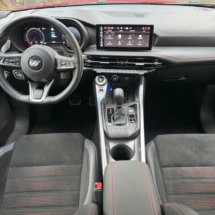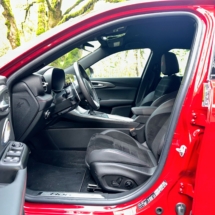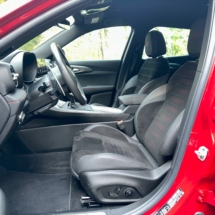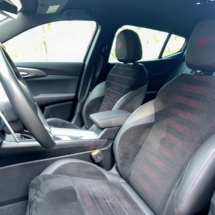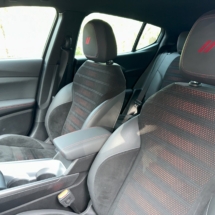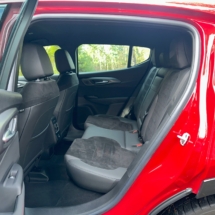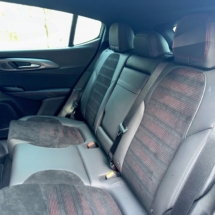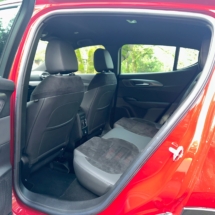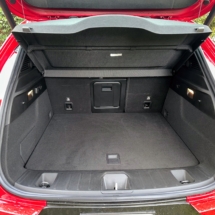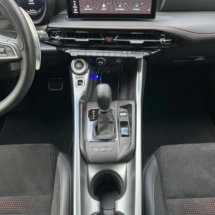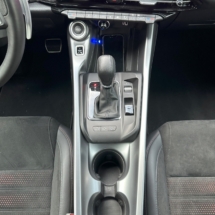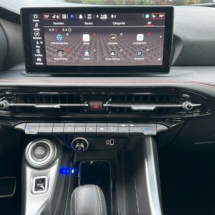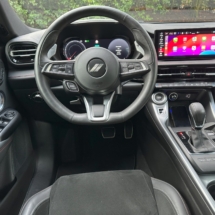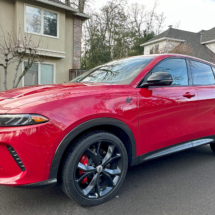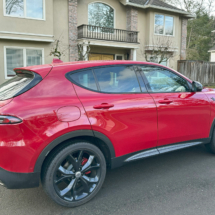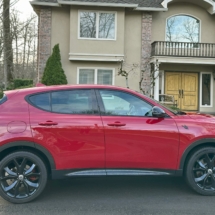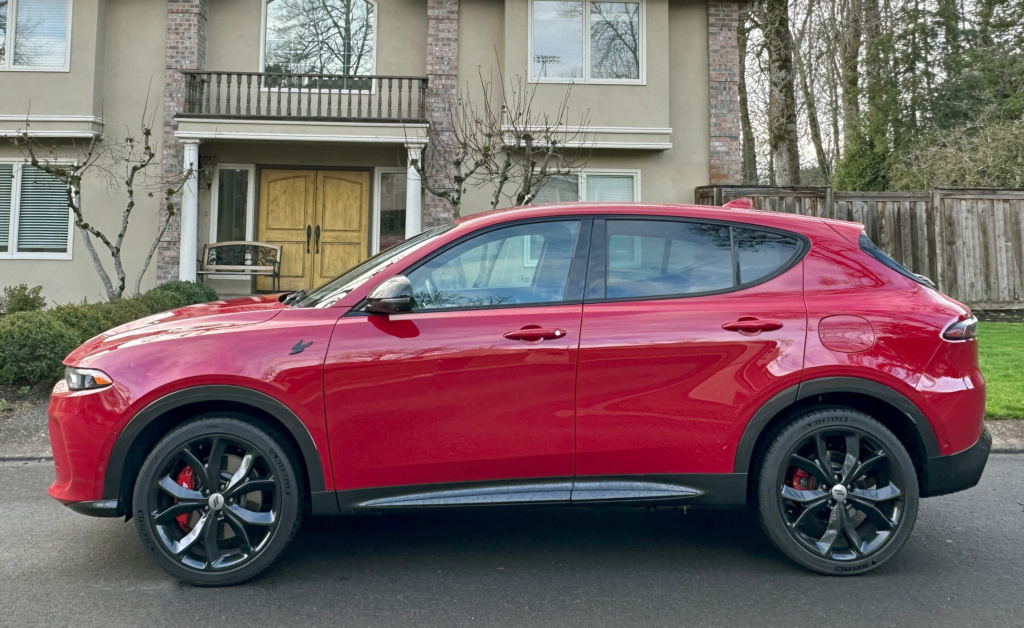
In a world where most SUVs and crossovers look much the same, the all-new 2024 Dodge Hornet R/T stands out as being a plug-in hybrid that’s also a muscle car. It’s the first electrified performance vehicle from Dodge. It has an all-electric range of about 32 miles.
Base Price: $44,995
As Tested: $52,305
Horsepower: 288
Mileage: 77 MPGe combined electricity + gas / 29 mpg gas only
The five-passenger 2024 Dodge Hornet plug-in hybrid comes in two trims: R/T and R/T Plus. Starting prices are $41,400 and $46,400.
The Hornet R/T is powered by a 1.3-liter turbocharged inline four-cylinder engine, two electric motors, and a 15.5 kWh lithium-ion battery pack. Total output is 288 horsepower and 383 pound-feet of torque. The transmission is a six-speed automatic.
There are three different drive modes, including all-electric, hybrid and gasoline only.
You can beef up performance with the PowerShot feature which provides a boost of 30 hp and adds instant torque. Dodge says PowerShot trims 1.5 seconds off normal 0 to 60 mph times by boosting horsepower and acceleration using 15-second bursts of extra power deployed by the battery and electric motor. Dodge says this makes the Horney R/T the quickest and most powerful utility vehicle in the segment.
PowerShot sounds impressive but in reality it’s not as cool as it sounds. I noticed just slightly quicker acceleration. And it takes some effort to engage – you have to pull both aluminum shift paddles on the steering wheel toward you, which can make it tough to steer in that moment.
Even with the underwhelming PowerShot, the Dodge R/T is fun to drive in everyday situations and a blast to take out on twisty backroads. Acceleration is brisk – it can go from zero to 60 mg in 5.6 seconds. Steering and brakes are responsive, and the brakes have a normal feel – not squishy like some hybrids and EVs. AWD keeps the Hornet planted (while the driver is grinning from the fun ride!).
The range of the battery is about 32 miles. However, the gas tank is small – at only 11.2 gallons – which means you have about 210 miles with gas, making the total gas and EV range of only 240-250 miles, depending on your driving style.
Charging time takes about 2.5 hours with a Level 2 (240-volt) charger. With a Level 1 (regular household 120-volt plug), it takes about eight hours.
Dodge fans will note that the interior has similarities to the Charger and Challenger. Adults in both rows enjoy decent leg- and headroom; however, the optional sunroof does cut down on headroom. Seats are comfortable and the front seats have bolstering on both sides to hold the driver and passenger in place on the track or those twisty back roads. However, the back seats could use a bit more padding.
Standard features include rearview camera, dual-zone automatic climate control, cloth and synthetic leather upholstery, eight-way power-adjustable driver’s seat with memory settings, heated front seats, heated and leather-wrapped steering wheel, 12.3-inch digital instrument cluster, infotainment system with 10.25-inch touchscreen, six-speaker audio system, satellite radio, Bluetooth, Android Auto and Apple CarPlay, USB ports, Wi-Fi hot spot, rain-sensing windshield wipers, automatic high-beam headlights, and a universal garage door opener.
Available features include a surround-view camera system, real leather upholstery, Alcantara leather upholstery, eight-way power-adjustable passenger seat, ventilated front seats, Harman Kardon premium audio system, HD Radio, navigation, wireless device charging and a sunroof.
Standard driver assistance technologies include forward collision warning, adaptive cruise control, lane-keep assist, blind-spot monitoring, pedestrian and cyclist detection, traffic-sign recognition, rear cross-traffic alert, and rear park assist.
Available driver assistance technologies include lane-centering assist, parallel and perpendicular park assist, front, rear and side parking sensors, and driver-attention monitoring.
The Uconnect 5 infotainment system is user-friendly and the standard 10.25-inch touchscreen looks sharp with modern graphics. Handy physical controls make it easy to adjust audio and climate settings. However, you do have to go through the touchscreen to adjust the heated and ventilated seats and heated steering wheel.
Cargo space is below average for a hybrid SUV as the battery pack eats into some space. There are 22.9 cubic feet with both rows of seats in place, and 50.5 cubes with the second row folded. There’s a pass-through for long items such as skis. A power liftgate is available.
The good:
Stands out from other crossovers and plug-in hybrids
Energetic acceleration
Fun to drive
Decent all-electric range
Lots of standard and available features and tech
User-friendly infotainment system
Standard Android Auto and Apple CarPlay
The not-so-good:
PowerShot sounds good but is gimmicky
Below average cargo space
Pricing info:
My tester starts at $44,995. The Blacktop Package is $1,595 and includes gloss black painted mirror caps, dark “Hornet” badge, dark GT badge, gloss black painted side window moldings, 18-inch x 7.5-inch Abyss finish wheels, and 225/55R 18 all-season tires. The Tech Pack is $2,245 and includes intelligent speed assist, active driving assist system, surround view camera system, drowsy driver detection, and ParkSense front/rear/side park assist. Track Pack is $2,595 and includes black Alcantara seats with red accents, aluminum door sills, sport leather steering wheel, duel mode suspension, bright pedal, red painted Dodge calipers, 20-inch x 8.0-inch Abyss finish wheels, and 235/40R20 all-season tires. The Hot Tamale exterior color is $495. Credit for no sunroof is $615. The bundle discount R/T is $600. Destination fee is $1,595 bringing the grand total to $52,305.
Bottom line:
Stellantis has done a good job in making a plug-in hybrid that’s worthy of the Dodge brand and Hornet name. The 2024 Dodge Hornet R/T stands out among SUVs and crossovers with its looks and performance, and has an all-electric range of 32 miles so you can limit those stops at the gas station.


